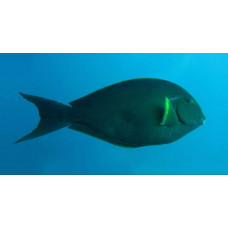Latin name
Acanthurus albipectoralis
Other name
White-fin surgeon
Identification
Whitefin surgeonfish have 22 vertebrae. The smallest depth of the caudal trunk is 3.1-3.3 times the length of the head.
Features of fish fins
Dorsal spines (total): 8 - 9; Dorsal soft rays (total): 22 - 33; Anal spines: 2 - 3; Anal soft rays: 18 - 31.
Fish colouring
The body coloration varies from light bluish gray to dark brown, without blue lines. The outer part of the pectoral fins is white, the edge is curved so that the pale area is widest in the middle part of the fin.
Distribution
Widespread in the tropical waters of the western and central Pacific. Occurs in Australia, Fiji, New Caledonia, Samoa, Tonga, Vanuatu, Vietnam, Wallis and Futuna.
Habitat
It is a marine benthopelagic species. It inhabits the slopes of outer reefs facing the sea. The depth range is from 5 to 20 meters.
Size
The maximum length of a whitefin surgeonfish is 33 centimeters.
Behavior
Individuals of this species move individually, but more commonly in small groups.
Food and feeding habits
This species feeds primarily on small planktonic invertebrates.
Reproduction
During mating, females release eggs into the water and males release sperm. The eggs are fertilized and become part of the plankton that drift on ocean currents. Parental care then ceases.
Fishing
Have a minor commercial interest in the fishery.
Relationship with a person
Harmless.
| Classification | |
| Phylum | Chordata |
| Class | Actinopterygii |
| Squad | Acanthuriformes |
| Family | Acanthuridae |
| Genus | Acanthurus |
| Species | A. albipectoralis |
| Features | |
| Conservation status | Least Concern |
| Habitat | Pelagic |
| Life span, years | No information |
| Maximum body weight, kg | No information |
| Maximum length, cm | 33 |
| Sailing speed, m/s | No information |
| Threat to people | Not edible |
| Way of eating | Planktonophage |
Whitefin surgeonfish
Tags: whitefin surgeonfish

